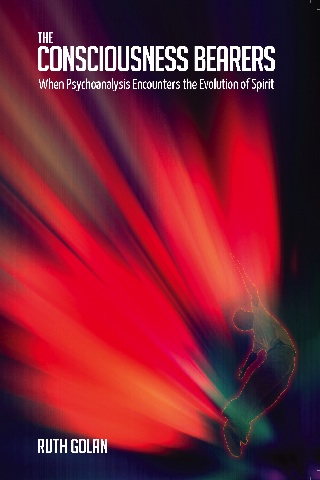
Description:
This Book contains articles that deal with the spiritual context of life, looking at psychoanalysis from a new angle. It includes an integrative model that places the psychoanalytical insights on the human psyche in a wider context of the evolutionary process. The author posits that the awakening of the spiritual impulse is an aspiration to higher consciousness, to subtler perception that is expressed in the spiritual impulse as the movement or action towards conscious evolution. It is a development of awareness to three things: to the absolute dimension, to the relative dimension, and to the fact that they are one.
e x c e r p t
Eppur si muove! —
nevertheless, it does move!
This short essay gives an initial outline of a broader
research project. The project was conducted in order to
re-examine some of the conclusions reached from viewing
psychoanalysis not as a form of scientific, philosophical, or
even psychological research, but as research that includes
the researching subject—meaning that psychoanalytic research
is inseparable from clinical work.
The purpose of such research is not merely to gather
information or knowledge, but to reveal elements relating
to truth and cause in a way that will influence and bring
about change, and transformation.
This concept is valid in relation to both praxis and, in a
different way, learning. Transformation is movement of the
psyche—in a specific direction.
With the opening of the Clinical Section in Paris in
1977, Lacan established the couch as the clinic. He said
that we have to “clinicize”—to lay the patient down. He
meant that the term “clinic” should lead us to reconsider
our own clinical work: the treatment we give, our transition
from the position of analysand to that of analyst, and the
way we relate to transference. Lacan used the opportunity
to assert that “Clinical psychoanalysis must consist not only
of analytic examination but also examination of the analysts”
(Lacan, 1977b).
I feel that it is too easy for us to forget what Lacan really
meant by allowing ourselves to be satisfied merely by the
more interesting intellectual and theoretical elements of
psychoanalysis.
Sometimes even testimonies regarding the Pass process4
seem to be no more than a creative way of expressing analytic
insights, devoid of real effects. This is both stimulating
and worrying. A glance at working relationships within the
analytic institution, for example, can leave one wondering
in regard to the effect that psychoanalysis has on the analysts
themselves.
At this point, I tend to believe that we fail to apply our
professional ethics in our personal lives. As soon as we get
up off the analyst’s armchair, we stop being ready to listen
freely and openly, to cast off our tendency towards narcissism
and to contemplate in a way that is free of ego.5
4 The Pass is the process invented by Lacan in which the analysant testifies to
the theoretical conclusions he derived from his own analysis.
5 The concept of the ego is used in psychoanalysis as the organizing structure
of the psyche. Both in psychoanalysis and in spiritual teachings the ego is
considered as an agency who is fixated in the narcissistic perception of the
There is a difference between curiosity about psychoanalytic
knowledge and studying it, because we have a sense
that our fate depends on there being new breakthroughs
in the field. When questions do start to be asked, genuine
answers are generally found, but the real answers can seem
too big for us to deal with because they require transition
from the known to the unknown and a change in our
ethical position. That is why we tend to bury the answers
in a sheath of knowledge—”Interesting, I’d like to look into
that.” That is how we make sure that we will always be students.
This course of action involves a lot of enjoyment,
identification with psychoanalysis as an ideal, and identification
with the ideals of psychoanalysis.
The critical question relates to the motive behind the
research—or the desire that empowers the research. The
individual that approaches psychoanalysis in order to
know also wants to know about himself and his place in
the world. I call such knowledge “living” or “erotic” knowledge—
the opposite of the knowledge of universities.
Whether or not a person admits it, there is a sense of dissatisfaction
with what already exists, a hunger for deeper
experience of being.
So psychoanalysis is really a kind of psychic motion.
Or, more precisely, psychoanalysis deals with the conflict
self and the world. In this book I use the word “I” to mark the psychoanalytic
concept (this is in fact the word that Freud uses—Das Ich), and the word
“ego,” to mark the narcissistic self.
between the dynamics of progress, regression, going round
in circles, or being stuck in one place—a dynamic of internal
and external events, of drives and representations,
occurring within the framework of time.
§ The libido
Such dynamics are based on Freud’s concept of libido.
Lacan’s initial definition of libido aided him in constructing
the “mirror stage,” the stage at which the ego becomes
fixated. Miller used Lacan’s scheme to illustrate the imaginary
connection that runs between a and a’,6 with the libido
in a circular motion, representing complete connection at
the level of enjoyment—the level of libidinal drive. His definition
is based on Freud’s essay “On Narcissism” (Freud,
1914c). The connection at the imaginary level interferes
most foully with the inter-subjective connection, blocking
it, making it fixed and repetitive (Miller, 1995–96).
The axis upon which the libido registers obstructs the
subject’s symbolic connection with the Other, even to the
point of disconnecting it. Enjoyment cuts off the genuine
connection with the Other. As Miller put it, in psychoanalysis
one has to overcome the libidinal connection in order
to facilitate a genuine connection with the Other. When
treatment is steered in the right way, enjoyment ultimately
6 ego and other
gives way, allowing for the motion itself to be transformed.
Lacan distinguished between two opposing types of
libido:
1. Libido in a repetitive cycle from the ego to the world
outside, in narcissistic terms—libido that can be
transferred.
2. That which he termed “The libido of phallic auto-eroticism”—
fixated, stagnant libido.
“The imaginary function is what Freud formulated to
govern the investment of the object as a narcissistic object”
(Miller, 1995–96).
The permanent element of this circulation is phallic. In
distinguishing between the two opposing forms—transitory
and fixated—Lacan established the basis of what he
later called the model of enjoyment.
In The Four Fundamental Concepts of Psychoanalysis,
Lacan wrote:
“Everything that Freud spells out about the partial
drives shows us the movement that I outlined for you on
the blackboard last time, that circular movement of the
thrust that emerges through the erogenous rim only to
return to it as its target, after having encircled something
I call the objet a. I suggest—and punctilious examination
of this whole text is a test of the truth of what I propose—
that it is in this way that the subject attains what is, strictly
speaking, the dimension of the capital Other.
I suggest that there is a radical distinction between
loving oneself through the other—which, in the narcissistic
field of the object, allows no transcendence to the
object included—and the circularity of the drive, in which
the heterogeneity of the movement out and back shows a
gap in its interval” (Lacan, 1964, p. 194).
Lacan located the libido of Freud in that gap created by
the periodicity of the drive. In Lacan’s XIth seminar (1964),
he saw libido not as energy but as an organ, the substance
of the Real7: biological life, unlimited by life or death. The
libido represents life as something that cannot be annihilated,
the pure drive of life—beyond the genealogical chain
of sexual procreation. The libido, therefore, is a result of the
separation between biological sexuality and human sexuality—
as dictated by the symbolic order.
When Lacan began to teach, he thought that it would
suffice to contend that it is not the signifier that attracts the
libido but the image, the reflection. In time, he discarded
this explanation because he discovered that the signifier
itself is saturated with libido. He noted the material dimension
of language and then distinguished the split subject
as a non-libidinal effect of the signifier—a dead subject, an
effect of signifiers—from objet á as a loaded effect of the
7 The Real is one of the three orders through which Lacan described the structure
of the psyche. The other two are the Imaginary and the Symbolic. The
Real is different than reality. It is what is excluded from the symbolic net
language and culture. It is what one bumps into, about which one cannot say
anything, only talk around it. The Real is the traumatic.
signifier. The signifier therefore has both a fatal effect in
regard to the subject and a life-giving effect—enjoyment.
In this context, objet á is the symptom.
§ Fixation—the ego
The remarkable similarity between Buddhist teachings
and the way Freud and Lacan establish the ego as an object
was, for me, a novel and exciting revelation. According to
both views, the object is formed out of the building blocks
of identifications and is structured as a shield or screen to
protect from unmediated encounters with the bodily or
worldly Real.
The ego serves as a defense mechanism in the face of
the dynamic uncertainty of the subject of the unconscious,
its inherent otherness, and the sense of the uncanny that
accompanies such encounters. Because of the imaginary
fixation on the ego as our identity (Eastern wisdom refers
to such fixation as “attachment”), the ego resists movement
or change in desire. In analytic practice, the ego is considered
to be a source of resistance and fixation. Reinforcing
it merely serves to increase resistance. The attachment of
the ego is the personal, imaginary perspective, which puts
a stop to motion.
By undermining the attachment to the ego, psychoanalysis
tries to restore the movement of desire, of its dialectic,
to open up a free space in which the subject can dwell and
move more freely through life’s contingencies.
For Lacan as for Freud, the ego is not a subject but an
object, constructed out of fixated identifications. It is but a
structure formed by identification with the specular image
of the “mirror stage.” This is the place where the subject
becomes alienated from itself, becoming its fellow men.
In a structural sense, such alienation is similar to paranoia.
Therefore, the ego is an imaginary product, the locus of
resistance.
Thus, Lacan was very much against the idea that psychoanalysis
should reinforce the ego. Since the ego is the
seat of our illusions, reinforcing it only serves to facilitate
further alienation and fixation of the subject.
The ego therefore constitutes the principal source of
resistance to analysis. Since it is essentially fixed in the
imaginary realm, it resists all subjective growth and change
and also the dialectic motion of desire. By undermining the
fixation of the ego, analysis attempts to restore the dialectic
of desire and to usher in the subject’s being.
Where does Lacan locate the ego in the make-up of the
psyche? In the XXth Seminar (1972-3), Lacan distinguished
between the two bodies that psychoanalysis relates to. One
is the body defined by language—what is said about it and
the way it is treated and touched. It is a sexual body in a
process of birth and death. The other is the organism—that
conglomeration of flesh imbued with inextinguishable life.
In this sense, language constitutes a kind of parasite on
the organism, constructing as it does the symbolic body.
We have two bodies—one mounted on the other and
two languages—one mounted on the other. Language is
mounted on the lalangue8. The process of recognition or
the revelation of this is a reverse process: from the body
to the organism. There is language and there is lalangue.
However, I believe that the kind of speech that comes
from the ego that Lacan refers to as “blah-blah” constitutes
a third type of speech. This third form of speech is the
talk of self-importance and knowledge that bestows false
authority—it acts as a screen that covers the living, pulsating
knowledge in the Real, which is connected with the
unknown (Lacan, 1972-3).
Perhaps for Lacan the ego was a hybrid creature, connecting
the organism—the body per se—with the symbolic
body, or connecting the speaking being [parlêtre] with the
subject when it is based on the pleasure principle.
I contend that in place of the non-existent sexual connection,
we tend to construct an imaginary sexual link with
our own ego, which becomes one of the principal obstacles
8 This is the name Lacan gave to the tonic language, a language that is constructed
from meaningless syllables like baby talk or like sounds that a
couple can exchange while making love.
to analysis. We are trapped in phallic enjoyment in regard
to our own self-image—our thoughts, moods, ideas, and
so forth. They seem to us highly unique and important,
whereas they are, in effect, the cause of our suffering. We
find such suffering so very hard to give up because it constructs
our “identity.”
Time after time we come across clear examples of this
phenomenon in our clinical work. However, apart from
it being critical to psychoanalytic training, how will the
analyst, when captivated by his own ego, be able to apply,
for example, free-floating attention? (free of self-image,
identifications, the known).
§ Horizontal and vertical movement
In psychoanalytic terms there are two forms of motion:
there is repetitive cyclic motion, the motion of drive around
the object causing enjoyment, and there is also the developing
form of vertical motion.
Thus, the subject can go from fixation and compulsive
repetitiveness to acting from free choice.
Ken Wilber (2001), an influential contemporary thinker
and expert on Eastern and Western knowledge, distinguishes
between the two functions offered by religion, but
the distinction he makes can also apply to various fields in
our culture—particularly psychoanalysis.
Wilber distinguishes between horizontal and vertical
movement. He refers to horizontal movement as “translation”—
motion that generates meanings, deepening
understanding, stories, interest, and interpretation. Horizontal
motion only serves to reaffirm and reinforce the I.
It cannot bring about a change in our level of awareness. It
cannot liberate us from the ego.
There is also vertical movement—the movement of
radical transformation and liberation. This kind of movement
is characteristic of a tiny fraction of the population.
Instead of reinforcing the fixated ego, it has the potential to
destroy it. It is about emptiness rather than fullness, as well
as revolution. Wilber refers to it as “transformation.” Vertical
motion puts the very process of translation in doubt,
shatters it. With translation, the I finds new ways of thinking
about the world. Transformation means changing the
world rather than translating it.
The process of translation gives legitimacy to the I and
its beliefs. Without translation there would be social chaos.
Individuals who cannot translate with a reasonable level
of integrity and precision—who are unable to construct a
world of significance—fall into psychosis. The world ceases
to be understood, and the boundaries between the world
and the I begin to disintegrate. This is not a breakthrough—
this is a crisis, disaster rather than transcendence.
While translation has a vital function, there is a point at
which it can no longer console and no new paradigms or
myths can allay the sense of distress. The only way out is
transformation—individually and collectively.
§ From the personal to the particular via the
universal
Psychoanalytic treatment is a bit like starting out on
a journey and having to visit various places on the way—
starting from the personal, passing through the universal,
and arriving at the unique, the particular.
At the initial session with a new patient, my first question
is “What brings you here?” or “Why are you here?”
During the last session following nine years of treatment,
one of my patients asked me, with tears in her eyes,
“What have you brought me up for?” Her question came
as a surprise for me, like a retrospective interpretation,
shedding light on the entire nine-year process. It had a hairraising
effect, akin to her asking (like Jesus on the cross):
“My God, My God, why hast thou forsaken me?” Was that
what I had been doing in her analysis? Bringing her up?
In his essay “The Subversion of the Subject and the Dialectic
of Desire in the Freudian Unconscious,” Lacan said,
referring to his investigation of the unconscious, “to the
point at which it gives a reply that is not some sort of ravishment
or takedown, but is rather a ‘saying why’” (1966a,
p. 283). He refers to the cause.
I believe that the route along which analysis flows, runs
between the three questions, “What?” “What for?” and
“Why?”
Patients respond to the first question in personal
terms—their personal complaint, the story of their life,
their own personal pain and anxiety. Treatment revolves
around repetitive elements of their tale. From the repetition
arise the symptom, the complex, and a structural diagnosis.
The universal nature of his suffering—the structural
character (i.e., neurotic, psychotic, perverse, etc.)—comes
as an unpleasant surprise for the subject. The chaos of the
signifiers is reduced to a kind of formula. The personal has
to be taken through the universal prism, which changes the
position of the subjects and their narcissistic investment in
“being special.” That is the first step. The next is the recognition
of the enjoyment that is bound up with the subjects’
suffering and adhesion to their symptom.
The subjects assume responsibility for their position
regarding sexuation—their sexual preference—man or
woman (beyond biology and sex) and that special combination
of verbal enjoyment. These are the particular aspects
of their subjectivity.
Only through adopting the position of “I don’t know but
I want to know” can they “pass through” and grow from the
personal to the particular.
In this respect, drive belongs to the realm of universality.
Drive is the movement around the fallen object, freedom
from any object that can be perceived. Lacan defined the
essence of the drive as the trace of the Act. Once it used
to encircle our bodies, sealing off our empty erogenous
orifices, just as the breast blocked our mouths and voices
blocked our ears. Such partial organs are part of the totality
of the lamella, that part of the libido that is desexualized—
immortal, inextinguishable life.
Sexualization introduces death—the trace of an Act
rather than the Act itself. The movement of drive, the enjoyment
and satisfaction involved, are the movements of an
automaton. They belong to the realm of cyclic, horizontal
motion, and are not evolutionary.
Not so desire, which can never be satisfied. It has a metonymic
possibility—replacing one object with another.
There is also a dialectic faculty in Hegelian terms: generating
a new metaphor when it engages [tyché] with the Real.
The gist of philosophy, including Eastern philosophy,
has dealt with horizontal movement rather than with
evolution. Even in referring to movement—”Everything
flows” or “All is one”—it is the whole, the absolute, which
is being referred to. In psychoanalysis, the phallic dimension
constitutes a part of this totality. Like the movement
of a pendulum—creation and extinction—there is and then
there is not. The libido, too, has been characterized by the
movement of here/there, life/death, Fort/Da9. Even in the
Borromean context, which refers to four dimensions—
symbolic, imaginary, Real, and the object that connects
them—the connection is still cyclic: pincer grasped by
pincer, dimension gripped by dimension; a chain of signifiers.
In the past, vertical motion was the realm of the
religions, but they, too, failed to refer to the evolution of
consciousness, focusing instead on the development of
morality.
Although in the realms of science—quantum physics—
the border between matter and consciousness has been
rent asunder, to the best of my knowledge the subject of
research is not evolution—the new. There is a field, and
there are things that affect that field.
Psychoanalytic practice, however, deals with evolution—
personal, universal, and particular. This occurs through
praxis rather than theory. Analysis cannot be discussed
without discussing evolution—recognition of repetition,
the fall of the ideal, giving up enjoyment, and so on.
The next step is to stop trying to become: to recognize
the fact of partiality of the various passions and their limitations
and to break free of them—that is, liberation.
The various scientific theories regarding the expansion
9 Those are the words used by Freud’s grandson while playing with a reel in
a day that his mother was away, throwing it away and bringing it back. See
Freud’s article “Beyond the Pleasure Principle” 1920, p.100.
and contraction of the universe also have an evolutionary
element. This element exists in the anomalous, in the
“not everything.” Transition is the subject here—from the
phallic to the feminine, giving up enjoyment, inventing
knowledge, identification with the sinthome10.
What does psychoanalysis exist for if not to prevent
repetition? To liberate from fixation, to create a space for
desire to move in, to improve the representation of drive
with new metaphors? To fell the ideal? To leave identification
behind?
Lacan also referred to the Pass as a possibility for evolution
of knowledge through transmission.
§ The movement and training of the analyst
In referring to the training of psychoanalysts, Miller
(2002) talked about “formation”—training—and what lies
beyond training— “transformation.”
The question of training becomes more refined when
the objective is not only to accumulate knowledge but that
certain subjective conditions should emerge: transformation
of the subject’s being, or training for wisdom, like in
Zen—that is, subjective transformation without transmitting
any specialist knowledge.
10 Synthome—a structure which is created at the end of analysis with which
the subject can identify. It is constructed from a combination between the
word “symptפme” (symptom) and the word “saint homme” (holy man).
Training requires that the psyche mutate. Genuine training
transmits spirit and a path and is realized when the
individual develops a new character. In real training we are
always ready for surprises and the unknown—in the same
way that interpretation works as an Act that leads to change
in psychoanalysis. Study is not training. Miller’s concept, in
the wake of Lacan, says that proper training always starts
after study. It includes within it “ignoring what one already
knows” (Miller, 2002). Its aim is perfection.
In training—as in therapy—subjective transformation
.










